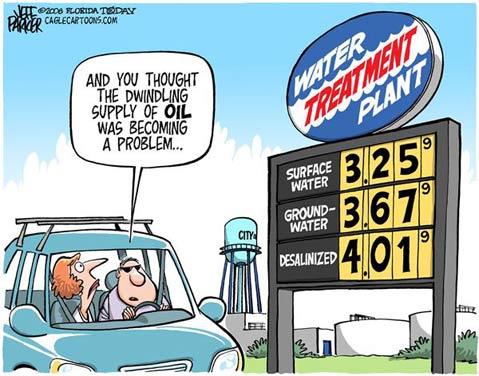Will There Be Enough Water for the Twin Tunnels?

Can a man drown crossing a river that averages one foot in depth? The answer is, of course, yes. An average cannot describe how wet you’ll get wading a river with a deep channel and a broader shallow run. In fact, the average is likely to represent only two points in the depth profile: the point where one descends and the point where one ascends the sides of the deep channel.
What does this math puzzle have to do with the State Water Project, past and future, especially the proposed “Twin Tunnels” project? Since the inception of the State Water Project, river runoff has been treated much like the river described above, a single record of 100 years without a sense of their individual characteristics, with similar resulting problems.
A little more than 50 of those 100 or so water-years can be characterized as dry, or as having much less than the overall average of the 100-year record. The other half of the record are wet years, with a central tendency much greater than the overall average. Few years fall near what is calculated to be the average of the 100-year record.
This results in two hydrologic records, and the problems of water deliveries from these two regimes are quite different. Water-years in the wet regime are generally no problem except for the hydraulic characteristics of the San Joaquin Delta in transferring water from north to south: There is plenty of water for all claimants.
The dry regime presents great difficulty since there are so many claimants to river runoff and there are river management requirements to be dealt with. For example, in the Sacramento Valley approximately 4.5 million to 5.0 million acre-feet of water must be delivered to “Settlement Contractors” and riparian water holders whose rights were well established before the Central Valley Project and the State Water Project were authorized. Then there are the lands in the Delta that have been farmed for years and have senior rights to fresh water in the Delta to those of the projects. Then there are the project contracts for delivery south of the Delta, which total just over 7 million acre-feet.
These amounts add up to just around the most likely runoff (or average) of the dry regime. And this leaves no allowance for the Delta outflow that is necessary for the health of the Delta.
Clearly, when we are operating in the dry regime, not everyone can be satisfied. In fact, for a fair number of years the projects will not get much water if senior rights in the Sacramento Valley and the Delta are first satisfied and an allowance is allocated for some minimum Delta outflow. The projects have never been correctly analyzed for these circumstances because the state Department of Water Resources’s modelers treat the entire runoff record as a single unit, just like the simplified and misleading analysis of the river described above.
Now what is interesting about the proposed Twin Tunnels is that they will do almost nothing to help solve the problems of dry-regime operations. The tunnels may help pass more water to south of the Delta during wet-regime years, but water managers south of the Delta have inadequate storage to take advantage of such deliveries. In other words the Twin Tunnels are no solution.
All this is actually an optimistic picture and excludes the operational constraints that sit on top of the dearth of water. The State Water Project and the Central Valley Project were designed around the requirement to fill the San Luis Reservoir near Los Banos in the San Joaquin Valley before the irrigation season began. And enough runoff had to flow into the Sacramento River before such filling began.
As it turns out, the window for filling San Luis Reservoir runs December through March. After March, the two projects’ main reservoirs, Shasta and Oroville, begin to fill, and then Sacramento Valley irrigation demands begin in mid-April. However, it can be February before runoff flows during dry years. If San Luis filling operations begin in December or January under those conditions, virtually no Delta outflow occurs and significant damage can occur to the Delta ecology. And if filling operations are delayed until February, there is not enough time to fill Shasta and Oroville.
The dry regime blows all these expectations out of the water, so to speak. When winter runoff is well below normal, a big spring runoff simply does not occur. A dry regime is dry throughout the water-year. The Twin Tunnels project will do nothing to help this fundamental problem.
So where does this leave us? If no significant amounts of water result, the project only leaves us with a tremendous capital investment to pay off. And that means a tremendous increase in water rates.
One other observation deserves comment: The current Delta configuration benefits Delta agriculture. Cross-Delta transfers depend critically on the integrity of the levees, so both agriculture and the water projects have a stake in the levees. If the Twin Tunnels are built, that shared interest will be severed. If the political clout of the corporate farmers in the San Joaquin Valley align with Southern California real estate interests, it will be very difficult to exercise the restraints on Delta pumping necessary to restore Delta health. There is little to recommend this project.
Arve Sjovold retired as chief cost scientist from Santa Barbara’s Tecolote Research, Inc. and served on the City Water Commission from 1967-1970. When the State Water Project contracts faced revisions known as the Monterey Amendment, Sjovold was a plaintiff representative to help DWR prepare a new environmental impact report. Sjovold’s membership on the DWR committee and his professional experience and understanding of DWR’s modeling of the State Water Project and the Central Valley Project inform this essay.



